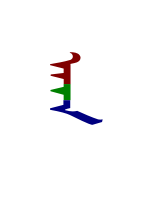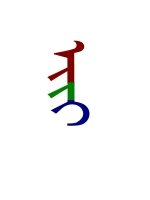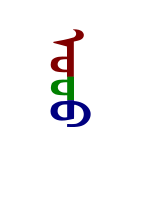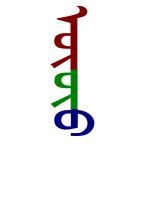Mongolian script
![]()
This article is about the classical Mongolian script. However, there are other Mongolian scripts.
The classical Mongolian script was the first of a whole series of Mongolian scripts developed or adapted for the Mongolian language. It is still used, with minor modifications, in Mongolia (since 1994 again alongside the Cyrillic script) and in China to write Mongolian and Evian. In China, the Mongolian script is widely used where Mongolian is an official language, i.e. in Inner Mongolia and in Fuxin, Harqin Left Wing, in the Front Gorlos, in Dorbod, Subei, parts of Haixi and Henan, and in Weichang. In addition, the official script of Western Mongolian is Tôdô Biqig in Bayingolin, Bortala, Hoboksar and parts of Haixi.
The script, an alphabet, was created in 1208 by the Uighur scribe Tatar-Tonga. He had been captured by the Mongols during a campaign against the Naimans and was then commissioned by Genghis Khan to establish a script for the Mongol language. For this purpose he adapted the Uighur alphabet to the new requirements. This in turn descended from the Aramaic script via the Sogdian alphabet. Its greatest peculiarity is the writing direction, it runs vertically from top to bottom and column-wise from left to right (all other vertical scripts go from right to left). The Uyghurs had their script (right to left, lines from top to bottom) rotated 90° counterclockwise to make it more similar to the vertical Chinese script.
Character
The individual signs take on different forms depending on whether they occupy an initial, medial or final position in the word. In some cases, there are additional graphic variants, the choice of which depends on the visual interplay with the character that follows.
The alphabet uses the same character for some vowel pairs (o/u, ö/ü, final a/e) and consonant pairs (t/d, k/g, sometimes ž/y) in Mongolian, respectively, which were not distinguished in Uighur. The result is roughly comparable to the situation in English, which has to represent 10 or more vowels with 5 characters, and uses the digraph th for two different sounds. Nevertheless, real ambiguities are relatively rare, since the requirements of vowel harmony and syllabification usually ensure a clear definition.
Alphabet
| Characters | Transliteration | Comments | ||||
| initial | medial | final | Lat. | Cyrillic | ||
|
|
|
| a | А | Distinction mostly by means of vowel harmony (see also q/γ and k/g). | |
|
| e | Э | ||||
|
|
|
| i, yi | И,Й, Ы, Ь | At the end of the word often absorbed into preceding syllable. | |
|
|
|
| o, u | О, У | Distinction by context. | |
|
|
|
| ö, ü | Ө, Ү | Distinction by context. | |
|
|
|
| n | Н | Distinction of medial and final a/e by position in syllable order. | |
|
|
| ng | Н, НГ | Only at the end of words (medial for composites). Transcribed Tibetan U+0F44; Sanskrit ङ. | ||
|
|
|
| b | Б, В | ||
|
|
| p | П | For Mongolian words, only initial. Transcribed Tibetan U+0F54; | ||
|
|
|
| q | Х | Only with back vowels. | |
|
|
|
| γ | Г | Only with back vowels. Between vowels today pronounced as a long vowel. | |
|
|
|
| k | Х | Mostly with front vowels. g between vowels is now pronounced as a long vowel. | |
| g | Г | |||||
|
|
|
| m | М | ||
|
|
|
| l | Л | ||
|
|
|
| s | С | ||
|
|
|
| š | Ш | The pronunciation of this sign has not changed. | |
|
|
|
| t, d | Т, Д | Distinction by context. | |
|
|
| č | Ч, Ц | Originally no distinction between /ʧ'/ and /ts'/, now by context. | ||
|
|
| ǰ | Ж, З | Distinction by context. Originally often interchangeable with y below. | ||
|
|
|
| y | Е, Ё, И, Ю, Я | Part of diphthongs, although actually a consonant. | |
|
|
|
| r | Р | Usually not initial. | |
|
|
| v | В | Transcribed Sanskrit व. | ||
|
|
| f | Ф | Classical Mongolian does not know this sound. | ||
|
|
| ḳ | К | Transcribed Russian К. | ||
|
|
| (c) | (ц) | Transcribed Tibetan /ts'/ U+0F5A; Sanskrit छ. | ||
|
|
| (z) | (з) | Transcribed Tibetan /dz/ u+0F5B; Sanskrit ज. | ||
|
|
| (h) | Transcribed Tibetan U+0F63; U+0FB7; | |||
Footnotes:
- ↑ After consonant transliterated as i.
- ↑ After vowel transliterated as yi, with rare exceptions such as naim (eight) or naiman.
- ↑ Character for syllable beginning (n-<vowel>).
- ↑ Character for syllable end (<vowel>-n).
- ↑ Examples: qa-γ-an (khan) becomes qaan. Some exceptions such as tsa-g-aan (white) remain.
- ↑ Example: de-g-er is shortened to deer. Some exceptions like ügüi (no) remain.
- ↑ Transcribed foreign words are usually preceded by a vowel. Example: Transcription of Русь (Russia) results in Oros.
Unicode
| 1800 ᠀ Birga | 1801 ᠁ Ellipse | 1802 ᠂ comma | 1803 ᠃ Item | 1804 ᠄ Semicolon | 1805 ᠅ 4 points | 1806 ᠆ Hyphen | 1807 ᠇ Syllable boundary | 1808 ᠈ mansch. comma | 1809 ᠉ mansch. Point | 180A ᠊ Nirugu | 180B ᠋ | 180C ᠌ | 180D ᠍ | 180E | |
| 1810 ᠐ 0 | 1811 ᠑ 1 | 1812 ᠒ 2 | 1813 ᠓ 3 | 1814 ᠔ 4 | 1815 ᠕ 5 | 1816 ᠖ 6 | 1817 ᠗ 7 | 1818 ᠘ 8 | 1819 ᠙ 9 | ||||||
| 1820 ᠠ A | 1821 ᠡ E | 1822 ᠢ I | 1823 ᠣ O | 1824 ᠤ U | 1825 ᠥ Oe | 1826 ᠦ Ue | 1827 ᠧ Ee | 1828 ᠨ Na | 1829 ᠩ Ang | 182A ᠪ Ba | 182B ᠫ Pa | 182C ᠬ Qa | 182D ᠭ Ga | 182E ᠮ Ma | 182F ᠯ La |
| 1830 ᠰ Sat | 1831 ᠱ Sha | 1832 ᠲ Ta | 1833 ᠳ Sync and corrections by n17t01 | 1834 ᠴ Cha | 1835 ᠵ Yes | 1836 ᠶ Ya | 1837 ᠷ Ra | 1838 ᠸ Wa | 1839 ᠹ Fa | 183A ᠺ Ka | 183B ᠻ Kha | 183C ᠼ Tsa | 183D ᠽ Za | 183E ᠾ Haa | 183F ᠿ Zra |
| 1840 ᡀ Lha | 1841 ᡁ Zhi | 1842 ᡂ Chi | 1843 ᡃ Todo long vowel | 1844 ᡄ Todo E | 1845 ᡅ Todo I | 1846 ᡆ Todo O | 1847 ᡇ Todo U | 1848 ᡈ Todo Oe | 1849 ᡉ Todo Ue | 184A ᡊ Todo Ang | 184B ᡋ Todo Ba | 184C ᡌ Todo Pa | 184D ᡍ Todo Qa | 184E ᡎ Todo Ga | 184F ᡏ Todo Ma |
| 1850 ᡐ Todo Ta | 1851 ᡑ Todo Da | 1852 ᡒ Todo Cha | 1853 ᡓ Todo Yes | 1854 ᡔ Todo Tsa | 1855 ᡕ Todo Ya | 1856 ᡖ Todo Wa | 1857 ᡗ Todo Ka | 1858 ᡘ Todo Gaa | 1859 ᡙ Todo Haa | 185A ᡚ Todo Jia | 185B ᡛ Todo Nia | 185C ᡜ Todo Dza | 185D ᡝ Sibe E | 185E ᡞ Sibe I | 185F ᡟ Sibe Iy |
| 1860 ᡠ Sibe Ue | 1861 ᡡ Sibe U | 1862 ᡢ Sibe Ang | 1863 ᡣ Sibe Ka | 1864 ᡤ Sibe Ga | 1865 ᡥ Sibe Ha | 1866 ᡦ Sibe Pa | 1867 ᡧ Sibe Sha | 1868 ᡨ Sibe Ta | 1869 ᡩ Sibe Da | 186A ᡪ Sibe Yes | 186B ᡫ Sibe Fa | 186C ᡬ Sibe Gaa | 186D ᡭ Sibe Haa | 186E ᡮ Sibe Tsa | 186F ᡯ Sibe Za |
| 1870 ᡰ Sibe Raa | 1871 ᡱ Sibe Cha | 1872 ᡲ Sibe Zha | 1873 ᡳ mansch. I | 1874 ᡴ Manch. Ka | 1875 ᡵ Manch. Ra | 1876 ᡶ mansch. Fa | 1877 ᡷ Manch. Zha | ||||||||
| 1880 ᢀ Ali Gali Anusvara One | 1881 ᢁ Ali Gali Visarga One | 1882 ᢂ Ali Gali Damaru | 1883 ᢃ Ali Gali Ubadama | 1884 ᢄ Ali Gali umgedr. Ubadama | 1885 ᢅ Ali Gali Baluda | 1886 ᢆ Ali Gali 3 Baluda | 1887 ᢇ Ali Gali A | 1888 ᢈ Ali Gali I | 1889 ᢉ Ali Gali Ka | 188A ᢊ Ali Gali Nga | 188B ᢋ Ali Gali Ca | 188C ᢌ Ali Gali Tta | 188D ᢍ Ali Gali Ttha | 188E ᢎ Ali Gali Dda | 188F ᢏ Ali Gali Nna |
| 1890 ᢐ Ali Gali Ta | 1891 ᢑ Ali Gali Da | 1892 ᢒ Ali Gali Pa | 1893 ᢓ Ali Gali Pha | 1894 ᢔ Ali Gali Ssa | 1895 ᢕ Ali Gali Zha | 1896 ᢖ Ali Gali Za | 1897 ᢗ Ali Gali Ah | 1898 ᢘ Todo Ali Gali Ta | 1899 ᢙ Todo Ali Gali Zha | 189A ᢚ Manch. Ali Gali Gha | 189B ᢛ Manch. Ali Gali Nga | 189C ᢜ Manch. Ali Gali Ca | 189D ᢝ Manch. Ali Gali Jha | 189E ᢞ Manch. Ali Gali Tta | 189F ᢟ Manch. Ali Gali Ddha |
| 18A0 ᢠ Manch. Ali Gali Ta | 18A1 ᢡ Manch. Ali Gali Dha | 18A2 ᢢ Manch. Ali Gali Ssa | 18A3 ᢣ Manch. Ali Gali Cya | 18A4 ᢤ Manch. Ali Gali Zha | 18A5 ᢥ Manch. Ali Gali Za | 18A6 ᢦ Ali Gali Half U | 18A7 ᢧ Ali Gali Half Ya | 18A8 ᢨ Manch. Ali Gali Bha | 18A9 ᢩ Ali Gali Dagalga | 18AA ᢪ Manch. Ali Gali Lha | |||||

The word "Mongol" in the classical script
Examples
Different forms
The same vowel written three times in connected form, red the form at the beginning of a word, green that within a word and blue that at the end of a word.
| a / e | i | o / u | ö / ü |
|
|
|
|
|
Historical forms
| Historical forms | Modern print | First word transliterated: | |||||||||||||||||||||
|
|
|
|
- Transliteration: Vikipediya. čilügetü nebterkei toli bičig bolai.
- Cyrillic: Википедиа, Чөлөөт Нэвтэрхий Толь Бичиг Болой.
- Transcription: wikipedia, tschölööt newterchii tolj bitschig boloi.
- Literally: Wikipedia, encyclopedia writing is free.
- Translation: Wikipedia, the free encyclopedia.
Questions and Answers
Q: What is Mongolian script?
A: Mongolian script is the first writing system to be used to write the Mongolian language. It is a cursive writing system, meaning that all the letters in a word always touch each other and change depending on if the letter is at the beginning, middle, or end of a word. It is also vertically written top-to-bottom and left-to-right, which makes it unique compared to other vertical writing systems like Chinese and Korean.
Q: What languages does Mongolian script write?
A: In addition to Mongolian, Mongolian script can also be used to write several other Mongolic and Tungustic languages such as Buryat, Kalmyk, Oirat, Manchu, and Xibe.
Q: How did Genghis Khan influence the development of Mongolian script?
A: In 1208 Genghis Khan captured a Uighur scribe named Tatar-Tonga and forced him to make the alphabet of his native language (the Old Uyghr alphabet) be used to write the Mongolian language. This was not successful as it did not fit well with the language and was difficult for native speakers to learn.
Q: Why was Cyrillic adopted by Mongolia?
A: After Mongolia became a communist state in 1941 Cyrillic replaced Mongolian script likely due to influence from their communist ally - The Soviet Union.
Q: Is Cyrillic more common than traditional Mongolian Script today?
A: Yes - due to lack of education in traditional writing style, lack of money for support and difficulty typing in traditional style on computers; more people are able read Cyrillic than traditional Mongoalain Script today.
Q: Does Inner Mongolia use both scripts or just one?
A: In Inner Mongolia most ethnic Mongols do not know how to read Cyrillic so they only use Traditional Mongoalain Script for reading purposes.
Search within the encyclopedia





